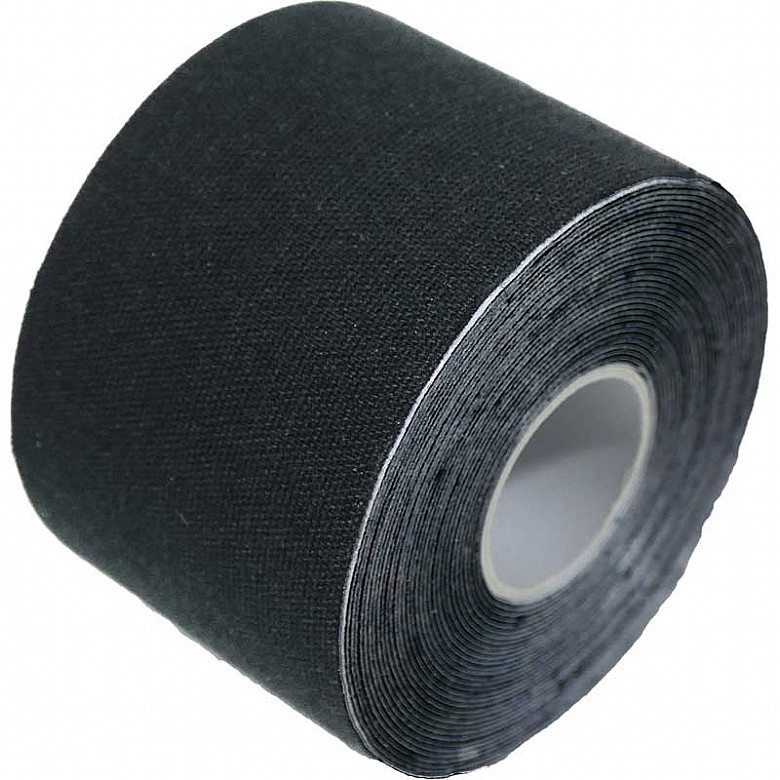
You may have seen marathon runners with colourful tape along their thighs and calves and wondered, “What’s that for?” That tape is known as kinesiology tape, and it’s designed to provide support, relieve pressure and ease swelling and pain. Many people use kinesiology tape during sports and other physical activities to prevent or treat injuries.
What is kinesiology tape?

Kinesiology tape is a durable and highly stretchy sports strapping made from a nylon/cotton blend. It is a commonly used sports first aid product and a useful addition to any sports first aid kit’s contents. The original design was developed in the late 1970s by a Japanese chiropractor, Dr. Kenzo Kase, who sought to create a supportive strapping that didn’t limit movement as much as other athletic tapes did. It can be applied to the body in specific places to reduce pain, lessen swelling and provide support. It is similar to EAB tape and zinc oxide tape, but is more stretchy.
How does kinesiology tape work?
The nylon and cotton construction of kinesiology tape makes it very stretchy. The blend is designed to emulate the elasticity of skin, allowing the user to maintain their full range of motion. Most kinesiology tapes use medical-grade adhesive, which means it’s water-resistant and strong enough to stick to the skin for up to five days.Creates space between the skin layers
When the tape is stretched slightly and applied to the body, it springs back, creating a lifting force on the top layer of the skin. This creates space between your skin and the tissues beneath it, thereby reducing pressure on pain receptors.A study on the effects of kinesiology tape on subcutaneous space determined that the tape does increase joint space when applied correctly.
Improves the circulation of blood and lymphatic fluids
When you’re injured, your body sends blood and other fluids to the affected area to start the healing process. This causes swelling and pain, which kinesiology tape can help to reduce. When the tape is applied, it creates extra space underneath the skin, enhancing the flow of blood and lymphatic fluid, aiding the healing process.The benefits of kinesiology tape
Enhances athletic performance
High level athletes in sports like running and cycling use kinesiology tape to achieve their highest level of performance and to protect against injury while they’re competing.Treats sports injuries
Physical therapists often use kinesiology tape as part of a comprehensive treatment plan for patients who have suffered joint or muscle injuries.Corrects posture and retrains muscles
The sensation of having kinesiology tape applied to your skin can help to make you more aware of how you’re standing and moving, and therefore aid in retraining learned muscle movements or posture.Supports weak muscles or joints
Kinesiology tape can also be used to support weak muscles or joints and facilitate strength training. Studies have shown that it can enhance endurance and movement when used on tired muscles. This is because the tape is much stretchier and more flexible than other athletic tapes and doesn’t hinder motion.When should you not use kinesiology tape?
There are many medical issues that kinesiology tape does not help to solve, and it can in some cases harm or hinder the healing process. Do not use kinesiology tape in the following situations:- Delicate or sensitive skin: If you have fragile skin that’s prone to breaking or tearing, avoid putting strong adhesives on it.
- On an open wound: Taping an open wound yourself will likely lead to further damage or infection.
- You have an allergy: If you’re allergic to strong adhesives, kinesiology tape will likely trigger a reaction. The adhesives on most tapes should be latex-free and hypoallergenic, however.
Read our other blogs for more information on first aid or contact us for further advice and information on our products.
About the author:
Jo Stokes is a writer, marketer and trained first aider at First Aid Online.
Find out more about Jo.
By Jo Stokes




